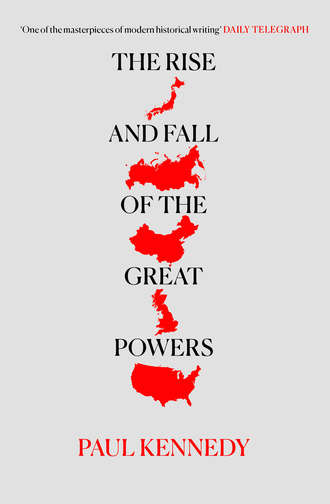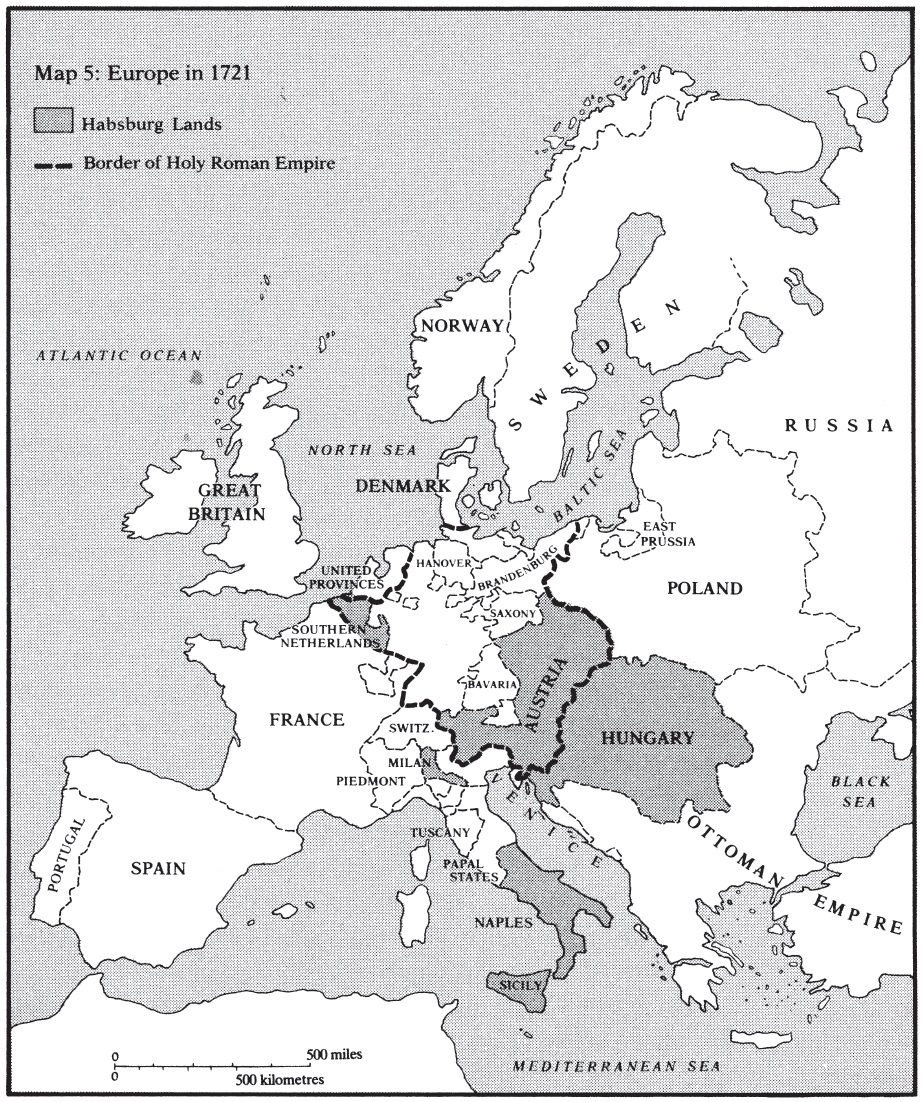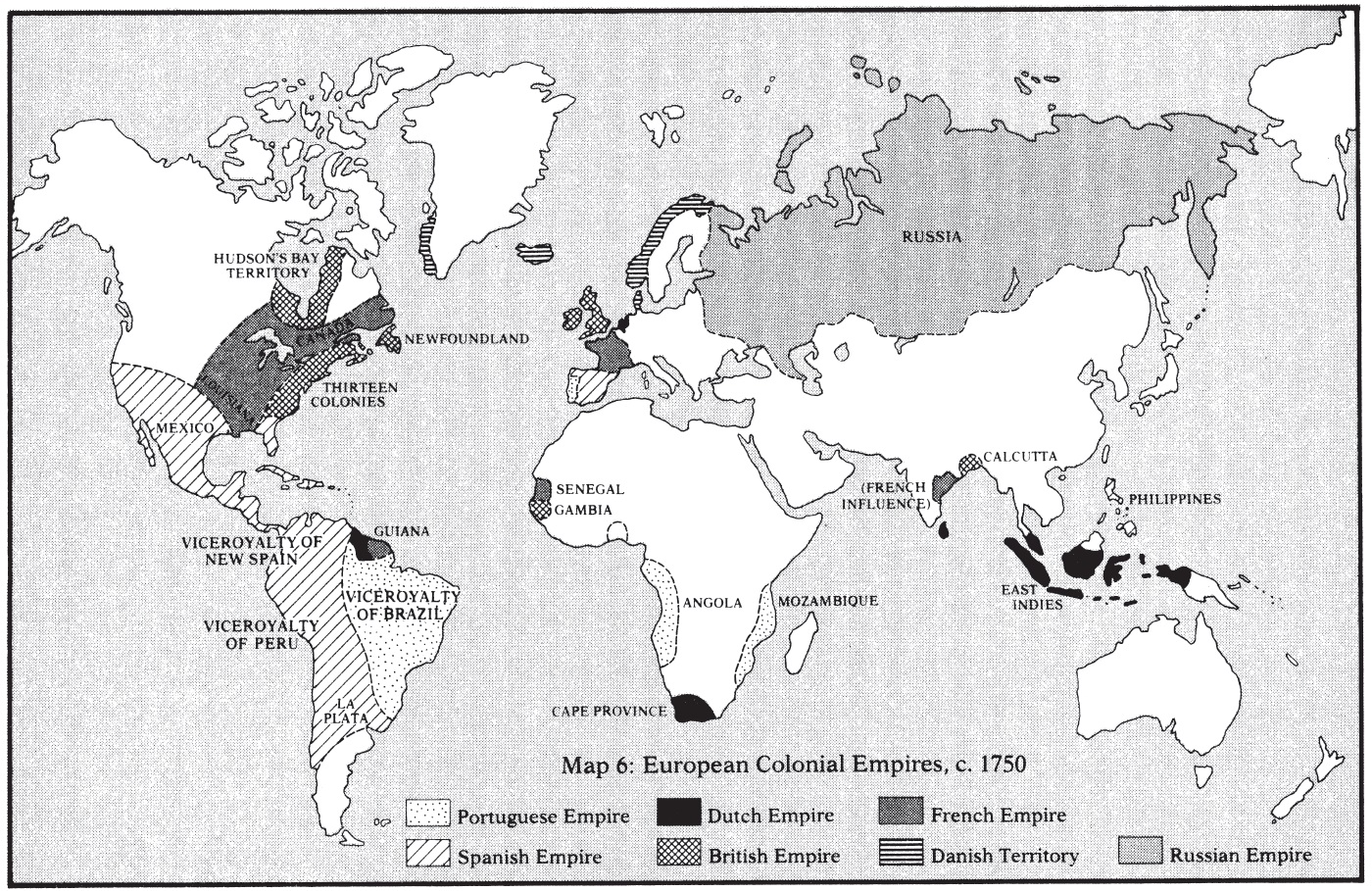
Полная версия
The Rise and Fall of the Great Powers
This general allied maritime superiority could not, however, prevent a resumption of French commerce-raiding, and by 1708 the Royal Navy had been forced to institute a convoying system in order to limit the losses to the merchant marine. And just as British frigates could not keep French privateers from slipping in and out of Dunkirk or the Gironde, so also were they unable to effect a commercial blockade, for that would have meant patrolling the entire Franco-Spanish coastline; even the seizure of corn ships off French ports during the dreadful winter of 1709 could not bring Louis’s largely self-sufficient empire to its knees.
This allied capacity to wound but not kill was even more evident in the military campaigns against France and Spain. By 1709 the allied invasion army was falling back from a brief occupation of Madrid, unable to hold the country in the face of increasing Spanish assault. In northern France, the Anglo-Dutch armies found no further opportunity for victories like Blenheim; instead, the war was grinding, bloody, and expensive. Moreover, by 1710 a Tory ministry had come into office at Westminster, eager for a peace which secured Britain’s maritime and imperial interests and reduced its expenses in a continental war. Finally, the Archduke Charles, who had been the allies’ candidate for the Spanish throne, unexpectedly succeeded as emperor, and thus caused his partners to lose any remaining enthusiasm for placing him in control of Spain as well. With Britain’s unilateral defection from the war in early 1712, followed later by that of the Dutch, even the Emperor Charles, so eager to be ‘Carlos III’ of Spain, accepted the need for peace after another fruitless year of campaigning.
The peace terms which brought the War of the Spanish Succession to an end were fixed in the treaties of Utrecht (1713) and Rastadt (1714). Considering the settlement as a whole, there was no doubt that the great beneficiary was Britain.54 Although it had gained Gibraltar, Minorca, Nova Scotia, Newfoundland, and Hudson Bay and trade concessions in the Spanish New World, it did not ignore the European balance. Indeed, the complex of eleven separate treaties which made up the settlement of 1713–14 produced a satisfying, sophisticated reinforcement of the equilibrium. The French and the Spanish kingdoms were to remain forever separated, whereas the Protestant succession in Britain was formally recognized. The Habsburg Empire, having failed in Spain, was given the southern Netherlands and Milan (thus building in further checks to France), plus Naples and Sardinia. Dutch independence had been preserved, but the United Provinces were no longer such a formidable naval and commercial power and were now compelled to devote the greater part of their energies to garrisoning their southern borders. Above all, Louis XIV had been finally and decisively checked in his dynastic and territorial ambitions, and the French nation had been chastened by the horrific costs of war, which had, among other consequences, increased total government debts sevenfold. The balance of power was secure on land, while at sea Britain was unchallenged. Small wonder that the Whigs, who returned to office on George I’s accession in 1714, were soon anxious to preserve the Utrecht settlement and were even willing to embrace a French entente once their archenemy Louis died in the following year.
The redistribution of power among the western European states which had occurred in this half-century of war was less dramatic than the changes which took place in the east. The borders there were more fluid than in the west, and enormous tracts of land were controlled by marcher lords, Croatian irregulars, and Cossack hosts rather than by the professional armies of an enlightened monarch. Even when the nation-states went to war against each other, their campaigning would frequently be over great distances and involve the use of irregular troops, hussars, and so on in order to implement some grand-strategical stroke. Unlike the campaigning in the Low Countries, success or failure here brought with it tremendous transfers of land, and thus emphasized the more spectacular rises and falls among the Powers. For example, these few decades alone saw the Turks pose their final large-scale military threat to Vienna, but then suffer swift defeat and decline. The remarkable initial response by Austrian, German, and Polish forces not only rescued the imperial city from a Turkish investing army in 1683 but also led to much more extensive campaigning by an enlarged Holy League.55 After a great battle near Homacs (1687), Turkish power in the Hungarian plain was destroyed forever; if the lines then stabilized because of repeated calls upon German and Habsburg troops against France during the 1689–97 war, the further defeats of the Turkish army at Zalankemen (1691) and Zenta (1697) confirmed the trend. Provided it could concentrate its resources on the Balkan front and possessed generals of the calibre of Prince Eugene, the Habsburg Empire could now more than hold its own against the Turks. While it could not organize its heterogeneous lands as efficiently as the western monarchies, nonetheless its future as one of the European great states was assured.
Measured by that criterion, Sweden was far less lucky. Once the young Charles XII came to the Swedish throne in 1697, the predatory instincts of the neighbouring states were aroused; Denmark, Poland, and Russia each desired parts of Sweden’s exposed Baltic empire and agreed in autumn 1699 to combine against it. Yet when the fighting commenced, Sweden’s apparent vulnerability was at first more than compensated for by its own very considerable army, a monarch of great military brilliance, and Anglo-Dutch naval support. A combination of all three factors allowed Charles to threaten Copenhagen and force the Danes out of the war by August 1700, following which he transported his army across the Baltic and routed the Russians in a stunning victory at Narva three months later. Having savoured the heady joys of battle and conquest, Charles then spent the following years overrunning Poland and moving into Saxony.
With the wisdom of retrospect, historians have suggested that Charles XII’s unwise concentration upon Poland and Saxony turned his gaze from the reforms which Peter the Great was forcing upon Russia after the defeat at Narva.56 Aided by numerous foreign advisers and willing to borrow widely from the military expertise of the West, Peter built up a massive army and navy in the same energetic way in which he created St Petersburg from the swamps. By the time Charles with a force of 40,000 troops turned to deal with Peter in 1708, it was probably already too late. Although the Swedish army generally performed better in battle, it suffered considerable losses, was never able to crush the main Russian army, and was hampered by inadequate logistics – such difficulties intensifying as Charles’s force moved south into the Ukraine and endured the bitter winter of 1708–9. When the great battle finally occurred, at Poltava in July 1709, the Russian army was vastly superior in numbers and in good defensive positions. Not only did this encounter wipe out the Swedish force, but Charles’s subsequent flight into Turkish territory and lengthy exile there gave Sweden’s foes nearer home their opportunity. By the time Charles finally returned to Sweden, in December 1715, all his trans-Baltic possessions had gone and parts of Finland were in Russian hands.
After further years of fighting (in which Charles XII was killed in yet another clash with the Danes in 1718), an exhausted, isolated Sweden finally had to admit to the loss of most of its Baltic provinces in the 1721 Peace of Nystad. It had now fallen to the second order of the powers, while Russia was in the first. Appropriately enough, to mark the 1721 victory over Sweden, Peter assumed the title Imperator. Despite the later decline of the czarist fleet, despite the great backwardness of the country, Russia had clearly shown that it, like France and Britain, ‘had the strength to act independently as a great power without depending on outside support’.57 In the east as in the west of Europe there was now, in Dehio’s phrase, a ‘counterweight to a concentration at the centre’.58
This general balance of political, military, and economic force in Europe was underwritten by an Anglo-French détente lasting nearly two decades after 1715.59 France in particular needed to recuperate after a war which had dreadfully hurt its foreign commerce and so increased the state’s debt that the interest payments on it alone equalled the normal revenue. Furthermore, the monarchies in London and Paris, not a little fearful of their own succession, frowned upon any attempts to upset the status quo and found it mutually profitable to cooperate on many issues.60 In 1719, for example, both powers were using force to prevent Spain from pursuing an expansionist policy in Italy. By the 1730s, however, the pattern of international relations was again changing. By this stage, the French themselves were less enthusiastic about the British link and were instead looking to recover their old position as the leading nation of Europe. The succession in France was now secure, and the years of peace had aided prosperity – and also led to a large expansion in overseas trade, challenging the maritime powers. While France under its minister Fleury rapidly improved its relations with Spain and expanded its diplomatic activities in eastern Europe, Britain under the cautious and isolationist Walpole was endeavouring to keep out of continental affairs. Even a French attack upon the Austrian possessions of Lorraine and Milan in 1733, and a French move into the Rhineland, failed to provoke a British reaction. Unable to obtain any support from the isolationist Walpole and the frightened Dutch, Vienna was forced to negotiate with Paris for the compromise peace of 1738. Bolstered by military and diplomatic successes in western Europe, by the alliance of Spain, the deference of the United Provinces, and the increasing compliance of Sweden and even Austria, France now enjoyed a prestige unequalled since the early decades of Louis XIV. This was made even more evident in the following year, when French diplomacy negotiated an end to an Austro-Russian war against the Ottoman Empire (1735–9), thereby returning to Turkish possession many of the territories seized by the two eastern monarchies.
While the British under Walpole had tended to ignore these events within Europe, commercial interests and opposition politicians were much more concerned at the rising number of clashes with France’s ally, Spain, in the western hemisphere. There the rich colonial trades and conflicting settler expansionism offered ample materials for a quarrel.61 The resultant Anglo-Spanish war, which Walpole reluctantly agreed to in October 1739, might merely have remained one of that series of smaller regional conflicts fought between those two countries in the eighteenth century but for France’s decision to give all sorts of aid to Spain, especially ‘beyond the line’ in the Caribbean. Compared with the 1702–13 War of the Spanish Succession, the Bourbon powers were in a far better position to compete overseas, particularly since neither Britain’s army nor its navy was equipped to carry out the conquest of Spanish colonies so favoured by the pundits at home.

The death of the Emperor Charles VI, followed by Maria Theresa’s succession and then by Frederick the Great’s decision to take advantage of this by seizing Silesia in the winter of 1740–1, quite transformed the situation and turned attention back to the continent. Unable to contain themselves, anti-Austrian circles in France fully supported Prussia and Bavaria in their assaults upon the Habsburg inheritance. But this in turn led to a renewal of the old Anglo-Austrian alliance, bringing substantial subsidies to the beleaguered Maria Theresa. By offering payments, by mediating to take Prussia (temporarily) and Saxony out of the war, and by the military action at Dettingen in 1743, the British government brought relief to Austria, protected Hanover, and removed French influence from Germany. As the Anglo-French antagonism turned into formal hostilities in 1744, the conflict intensified. The French army pushed northward, through the border fortresses of the Austrian Netherlands, toward the petrified Dutch. At sea, facing no significant challenge from the Bourbon fleets, the Royal Navy imposed an increasingly tight blockade upon French commerce. Overseas, the attacks and counterattacks continued, in the West Indies, up the St Lawrence river, around Madras, along the trade routes to the Levant. Prussia, which returned to the fight against Austria in 1743, was again persuaded out of the war two years later. British subsidies could be used to keep the Austrians in order, to buy mercenaries for Hanover’s protection and even for the purchase of a Russian army to defend the Netherlands. This was, by eighteenth-century standards, an expensive way to fight a war, and many Britons complained at the increasing taxation and the trebling of the national debt; but gradually it was forcing an even more exhausted France toward a compromise peace.
Geography as much as finance – the two key elements discussed earlier – finally compelled the British and French governments to settle their differences at the Treaty of Aix-la-Chapelle (1748). By that time, the French army had the Dutch at its mercy; but would that compensate for the steadily tightening grip imposed on France’s maritime commerce or for the loss of major colonies? Conversely, of what use were the British seizure of Louisburg on the St Lawrence and the naval victories of Anson and Hawke if France conquered the Low Countries? In consequence, diplomatic talks arranged for a general return to the status quo ante, with the significant exception of Frederick’s conquest of Silesia. Both at the time and in retrospect, Aix-la-Chapelle was seen more in the nature of a truce than a lasting settlement. It left Maria Theresa keen to be revenged upon Prussia, France wondering how to be victorious overseas as well as on land, and Britain anxious to ensure that its great enemy would next time be defeated as soundly in continental warfare as it could be in a maritime/colonial struggle.
In the North American colonies, where British and French settlers (each aided by Indians and some local military garrisons) were repeatedly clashing in the early 1750s, even the word ‘truce’ was a misnomer. There the forces involved were almost impossible to control by home governments, the more especially since a ‘patriot lobby’ in each country pressed for support for their colonists and encouraged the view that a fundamental struggle – not merely for the Ohio and Mississippi valley regions, but for Canada, the Caribbean, India, nay, the entire extra-European world – was underway.62 With each side dispatching further reinforcements and putting its navy on a war footing by 1755, the other states began to adjust to the prospect of another Anglo-French conflict. For Spain and the United Provinces, now plainly in the second rank and fearing that they would be ground down between these two colossi in the west, neutrality was the only solution – despite the inherent difficulties for traders like the Dutch.63
For the eastern monarchies of Austria, Prussia, and Russia, however, abstention from an Anglo-French war in the mid-1750s was impossible. The first reason was that although some Frenchmen argued that the conflict should be fought at sea and in the colonies, the natural tendency in Paris was to attack Britain via Hanover, the strategical Achilles’ heel of the islanders. This, though, would not only alarm the German states but also compel the British to search for and subsidize military allies to check the French on the continent. The second reason was altogether more important: the Austrians were determined to recover Silesia from Prussia; and the Russians under their Czarina Elizabeth were also looking for a chance to punish the disrespectful, ambitious Frederick. Each of these powers had built up a considerable army (Prussia over 150,000 men, Austria almost 200,000, and Russia perhaps 330,000) and was calculating when to strike; but all of them were going to need subsidies from the west to keep their armies at that size. Finally, it was in the logic of things that if any of these eastern rivals found a ‘partner’ in Paris or London, the others would be impelled to join the opposing side.
Thus, the famous ‘diplomatic revolution’ of 1756 seemed, strategically, merely a reshuffling of the cards. France now buried its ancient differences with the Habsburgs and joined Austria and Russia in their war against Prussia, while Berlin replaced Vienna as London’s continental ally. At first sight, the Franco-Austro-Russian coalition looked the better deal. It was decidedly bigger in military terms, and by 1757 Frederick had lost all his early territorial gains and the Duke of Cumberland’s Anglo-German army had surrendered, leaving the future of Hanover – and Prussia itself – in doubt. Minorca had fallen to the French, and in the more distant theatres France and its native allies were also making gains. Overturning the Treaty of Utrecht, and in Austria’s case that of Aix-la-Chapelle, now appeared distinctly possible.
The reason this did not happen was that the Anglo-Prussian combination remained superior in three vital aspects: leadership, financial staying power, and military/naval expertise.64 Of Frederick’s achievement in harnessing the full energies of Prussia to the pursuit of victory and of his generalship on the field of battle there can be no doubt. But the prize goes, perhaps, to Pitt, who after all was not an absolute monarch but merely one of a number of politicians, who had to juggle with touchy and jealous colleagues, a volatile public, and then a new king, and simultaneously pursue an effective grand strategy. And the measure of that effectiveness could not simply be in sugar islands seized or French-backed nabobs toppled, because all these colonial gains, however valuable, would be only temporary if the foe occupied Hanover and eliminated Prussia. The correct way to a decisive victory, as Pitt gradually realized, was to complement the popular ‘maritime’ strategy with a ‘continental’ one, providing large-scale subsidies to Frederick’s own forces and paying for a considerable ‘Army of Observation’ in Germany, to protect Hanover and help contain the French.

But such a policy was in turn very dependent upon having sufficient resources to survive year after year of grinding warfare. Frederick and his tax officials used every device to raise monies in Prussia, but Prussia’s capacity paled by comparison with Britain’s, which at the height of the struggle possessed a fleet of over 120 ships of the line, had more than 200,000 soldiers (including German mercenaries) on its pay lists, and was also subsidizing Prussia. In fact, the Seven Years War cost the Exchequer over £160 million, of which £60 million (37 per cent) was raised on the money markets. While this further great rise in the national debt was to alarm Pitt’s colleagues and contribute to his downfall in October 1761, nevertheless the overseas trade of the country increased in every year, bringing enhanced customs receipts and prosperity. Here was an excellent example of profit being converted into power, and of British sea power being used (e.g. in the West Indies) for national profit. As the British ambassador to Prussia was informed, ‘we must be merchants before we are soldiers … trade and maritime force depend upon each other, and … the riches which are the true resources of this country depend upon its commerce’.65 By contrast, the economies of all the other combatants suffered heavily in this war, and even inside France the minister Choiseul had ruefully to admit that
in the present state of Europe it is colonies, trade and in consequence sea power, which must determine the balance of power upon the continent. The House of Austria, Russia, the King of Prussia are only powers of the second rank, as are all those which cannot go to war unless subsidized by the trading powers.66
The military and naval expertise displayed by the Anglo-Prussian alliance, at least after the early setbacks, worked in the following way. At sea an enormous Royal Navy under Anson’s direction steadily imposed a blockade upon France’s Atlantic ports, and had sufficient surplus of force to mask Toulon and regain maritime supremacy in the Mediterranean as well. When fleet actions did occur – at Cartagena, off Lagos, and in Hawke’s incomparable gale-battered pursuit of Conflans’s fleet into Quiberon Bay – the superiority of British seamanship was made manifest time and again. What was more, this blockading policy – maintained now in all weathers, with the squadrons supplied by a comprehensive provisioning system – not only throttled much of France’s maritime trade and thus protected Britain’s commerce and its territorial security, but also prevented adequate reinforcements of French troops being sent to the West Indies, Canada, and India. In 1759, the annus mirabilis, French colonies were falling into British hands right across the globe, nicely complementing the considerable victory of the Anglo-German troops over two French armies at Minden. When Spain foolishly entered the war in 1762, the same fate befell its colonies in the Caribbean and Philippines.
Meanwhile, the House of Brandenburg had already seen its share of ‘miracles’, and in the battles of Rossbach and Leuthen, Frederick not only ruined a French and an Austrian army respectively, but also blunted the eagerness of those two nations to press into northern Germany; after Frederick caught the Austrians again, at Liegnitz and Torgau in 1760, Vienna was virtually bankrupt. Nevertheless, the sheer costs of all this campaigning were slowly grinding down Prussian power (60,000 soldiers lost in 1759 alone), and the Russian foe proved much more formidable – partly because of Czarina Elizabeth’s hatred of Frederick but chiefly because each encounter with the Russian army was such a bloody affair. Yet with the other combatants feeling the pace as well, and France keen to come to terms with a British government now also disposed to peace, Prussia found that it still had enough strength to keep the Austrians and Russians at bay until rescued by Elizabeth’s death in 1762. After this, and the new Czar Peter’s swift withdrawal from the war, neither Austria nor France could expect anything better than a peace settlement on the basis of a return to the prewar status in Europe – which was, in effect, a defeat for those who had sought to bring Prussia down.
In the 1762–3 settlements the one obvious beneficiary was again Great Britain. Even after returning various captured territories to France and Spain, it had made advances in the West Indies and West Africa, had virtually eliminated French influence from India, and, most important of all, was now supreme in most of the North American continent. Britain thus had access to lands of far greater extent and potential wealth than Lorraine, Silesia, and those other regions over which the continental states fought so bitterly. In addition, it had helped to check France’s diplomatic and military ambitions inside Europe and thereby had preserved the general balance of power. France, by comparison, had not only lost disastrously overseas but had also – unlike in 1748 – failed in Europe; indeed, its lacklustre military performance suggested that the centre of gravity had shifted from western Europe to the east, a fact confirmed by the general disregard of France’s wishes during the first partition of Poland in 1772. All this nicely suited British circles, satisfied with their own primacy outside Europe and not eager to be drawn into obligations on the continent.
The Winning of Wars, 1763–1815
The ‘breathing space’ of well over a decade which occurred before the next stage in the Anglo-French struggle gave only a few hints of the turnaround which would occur in British fortunes. The Seven Years War had so overstrained the taxable capacity and social fabric of the Great Powers that most leaders frowned upon a bold foreign policy; introspection and reform tended to be the order of the day. The cost of the war to Prussia (half a million dead, including 180,000 soldiers) had shocked Frederick, who now preferred a quieter life. Although it had lost 300,000 men, the Habsburg Empire’s army itself had not done too badly; but the overall governmental system was obviously in need of changes which would doubtless arouse local resentments (especially among the Hungarians) and consume the attention of Maria Theresa’s ministers. In Russia, Catherine II had to grapple with legislative and administrative reforms and then suppress the Pugachev revolt (1773–5). This did not prevent further Russian expansion in the south or the manoeuvres to reduce Poland’s independence; but those could still be classed as local issues, and quite distinct from the great European combinations which had preoccupied the powers during the Seven Years War. Links with the western monarchies were now less important.





